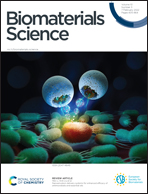Effect of the disulfide bond and polyethylene glycol on the degradation and biophysicochemical properties of polyurethane micelles†
Abstract
The disulfide bond has emerged as a promising redox-sensitive switch for smart polymeric micelles, due to its properties of rapid response to the reductive environment and spatiotemporally-controlled therapeutic agent delivery. However, the dilemma of multifunctional nanomedicine is that the more intelligent the functionalities integrated into a system, the vaguer the understanding of the structure and interaction between the multi-functional moieties becomes. To better understand the interaction between the disulfide bond and methoxy polyethylene glycol (mPEG), and their effects on the biophysicochemical characterization of micelles, we developed a series of polyurethane micelles containing various densities of disulfide bonds and bearing different molecular weights of mPEG. In this work, we found that the critical factor determining the degradation rate of polymer micelles was the hydrophobic/hydrophilic ratio of broken polymer segments triggered by disulfide bond breaking. The higher density of the disulfide bond and longer mPEG chain accelerate the degradation process due to the disproportionate hydrophobic/hydrophilic ratio of the broken chain, which is the key factor to determine the micellization and stabilization of polymer micelles. This work provides a fundamental understanding of the interaction between the complex functional groups and a new insight into the mechanism of the micelle degradation process, offering guidance on the rational design and fabrication of multifunctional nanoformulations.



 Please wait while we load your content...
Please wait while we load your content...